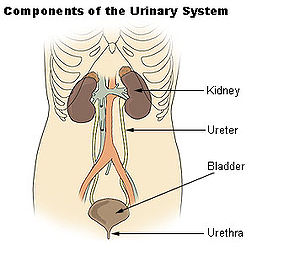
Osmotic diuresis
Encyclopedia

Urination
Urination, also known as micturition, voiding, peeing, weeing, pissing, and more rarely, emiction, is the ejection of urine from the urinary bladder through the urethra to the outside of the body. In healthy humans the process of urination is under voluntary control...
caused by the presence of certain substances in the small tubes of the kidneys. The excretion occurs when substances such as glucose enter the kidney tubules and cannot be reabsorbed (due to a pathological state or the normal nature of the substance). The substances cause an increase in the osmotic pressure
Osmotic pressure
Osmotic pressure is the pressure which needs to be applied to a solution to prevent the inward flow of water across a semipermeable membrane....
within the tubule, causing retention of water within the lumen, and thus reduces the reabsorption of water, increasing urine output (ie. diuresis). The same effect can be seen in therapeutics such as mannitol
Mannitol
Mannitol is a white, crystalline organic compound with the formula . This polyol is used as an osmotic diuretic agent and a weak renal vasodilator...
, which is used to increase urine output and decrease extracellular fluid volume.
Substances in the circulation can also increase the amount of circulating fluid by increasing the osmolarity of the blood. This has the effect of pulling water from the interstitial space, making more water available in the blood and causing the kidney to compensate by removing it as urine. In hypotension
Hypotension
In physiology and medicine, hypotension is abnormally low blood pressure, especially in the arteries of the systemic circulation. It is best understood as a physiologic state, rather than a disease. It is often associated with shock, though not necessarily indicative of it. Hypotension is the...
, often colloid
Colloid
A colloid is a substance microscopically dispersed evenly throughout another substance.A colloidal system consists of two separate phases: a dispersed phase and a continuous phase . A colloidal system may be solid, liquid, or gaseous.Many familiar substances are colloids, as shown in the chart below...
s are used intravenously to increase circulating volume in themselves, but as they exert a certain amount of osmotic pressure, water is therefore also moved, further increasing circulating volume. As blood pressure increases, the kidney removes the excess fluid as urine.
Sodium
Sodium
Sodium is a chemical element with the symbol Na and atomic number 11. It is a soft, silvery-white, highly reactive metal and is a member of the alkali metals; its only stable isotope is 23Na. It is an abundant element that exists in numerous minerals, most commonly as sodium chloride...
, chloride
Chloride
The chloride ion is formed when the element chlorine, a halogen, picks up one electron to form an anion Cl−. The salts of hydrochloric acid HCl contain chloride ions and can also be called chlorides. The chloride ion, and its salts such as sodium chloride, are very soluble in water...
, potassium
Potassium
Potassium is the chemical element with the symbol K and atomic number 19. Elemental potassium is a soft silvery-white alkali metal that oxidizes rapidly in air and is very reactive with water, generating sufficient heat to ignite the hydrogen emitted in the reaction.Potassium and sodium are...
are excreted in Osmotic diuresis, originating from Diabetes Mellitus
Diabetes mellitus
Diabetes mellitus, often simply referred to as diabetes, is a group of metabolic diseases in which a person has high blood sugar, either because the body does not produce enough insulin, or because cells do not respond to the insulin that is produced...
(DM). Osmotic diuresis results in dehydration
Dehydration
In physiology and medicine, dehydration is defined as the excessive loss of body fluid. It is literally the removal of water from an object; however, in physiological terms, it entails a deficiency of fluid within an organism...
from polyuria
Polyuria
Polyuria is a condition usually defined as excessive or abnormally large production or passage of urine . Frequent urination is sometimes included by definition, but is nonetheless usually an accompanying symptom...
and the classic polydipsia
Polydipsia
Polydipsia is a medical symptom in which the patient displays excessive thirst. The word derives from the Greek πολυδιψία, which is derived from πολύς + δίψα...
(excessive thirst) associated with DM.
External links
- Article at MedlinePlusMedlinePlusMedlinePlus is a free Web site that provides consumer health information for patients, families, and Health care providers. The site brings together information from the United States National Library of Medicine, the National Institutes of Health , other U.S. government agencies, and...

